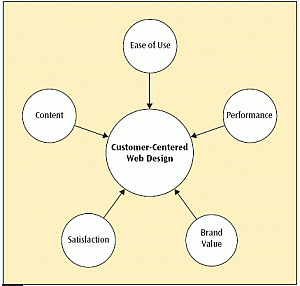Customer-Centered Web Design: More Than a Good Idea
[next]
Customer-Centered Web Design: More Than a Good Idea
By Douglas K. van Duyne, James A. Landay, and Jason I. Hong
The World Wide Web is no longer a novelty. To many companies and organizations, the Web is a necessity, the foundation of their businesses. As the cost of maintaining a customer service operation increases, the ability of Web site visitors to find information and complete specific tasks themselves can easily mean the difference between profit and loss. Customer-centered Web site design is therefore no longer a luxury adopted only by forward-thinking companies with a special interest in customer satisfaction.
Many of the design elements presented in this book are now the minimum requirements for an effective, professional Web site. As you work your way through the patterns that we discuss, consider how many high-quality sites you've seen that use the techniques described, and how much thought must have gone into their development. Implementing a customer-centered design is relatively easy when you have examples to work from and a wheel that has already been invented.
In this chapter you will discover the thinking behind customer-centered design and learn how to apply it to your projects using the principles, processes, and patterns that we present throughout this book.
The Evolution of Web Design
First Generation
The mantra was "build it, and they will come." Talented individuals and large teams alike built Web sites. These creative and visionary people managed everything from business planning to graphic design and software development in this new medium. Once having built the site, though, all they could say was that they had a Web site. They could not say how their site was performing from the customer's perspective, or how the site was related to the business's bottom line.
Second Generation
The mantra was "advertise that you sell it online, and they will come." Start-ups invested large amounts of capital in expensive ads to draw visitors to their e-commerce sites. Even established companies put ".com" on their letterhead and ran costly campaigns to let people know they hadn't been left behind.
Unfortunately, this strategy did not work, because Web design was complex and still misunderstood. For the first time, organizations were building interactive computer interfaces to their products and services. This task proved to be difficult to execute well. Building a Web site too quickly, in fact, made its probability of being both compelling and easy to use practically zero.
Third Generation

Figure 1.1 The key issues driving
customer-centered Web design.
With the first edition of this book we helped shift the mantra to "customer-centered design"—to constructing powerful Web sites that provide real value and deliver a positive customer experience.[1] When visitors consistently give a Web site high marks for content, ease of use, performance, trustworthiness (as well as other indicators of brand value), and overall satisfaction, we call it a customer-centered Web site. Consideration of these additional factors is what differentiates customer-centered design from other design approaches (see Figure 1.1).
[1] We use the term customer rather than user for three reasons. First, only two types of business people refer to their customers as users: drug dealers and computer companies. Second, and more importantly, the term customer evokes the idea that successful Web sites account for issues that go beyond ease of use and satisfaction, such as trustworthiness, brand value, and even how well a company's traditional interactions with the customer work, such as telephone-based customer service or the return of merchandise. Finally, taking a cue from Beyer and Holtzblatt's Contextual Design, we use customer to refer to anyone who uses or depends on the site. Customers can be administrators, partners, managers, and producers, among others. To manage the site, many of these individuals will see a completely different interface. We chose the term customer because it is more expansive than user, referring to all of these individuals and their myriad needs.
Fourth Generation
Today new technologies and business models have resulted in more innovative designs, but they also present greater challenges for building customer-centered Web sites. With the advent of AJAX (Asynchronous JavaScript And XML), the Mobile Web, and other Web 2.0 capabilities, sites can now provide features that are more compelling, more powerful, easier to access, and easier to use. However, building better interfaces now requires skills that are more specialized and harder than ever to acquire. In this edition of the book, we provide additional design patterns that enable you to build these customer experienceÂenhancing capabilities into your Web sites.
The challenge to be customer centered exists for all enterprises: large multinationals, government agencies, internal corporate services, small businesses, and nonprofit organizations, to name just a few. General Motors, for example, must manage its customer experience for more than three hundred end-customer, supplier, and distributor Web sites. Government sites, with responsibilities to help the citizenry and other agencies, need to satisfy "customer" requirements as well. Intranet applications that optimize a corporation's workforce must provide positive experiences to employee "customers."
[next]
URL:


 Find a programming school near you
Find a programming school near you